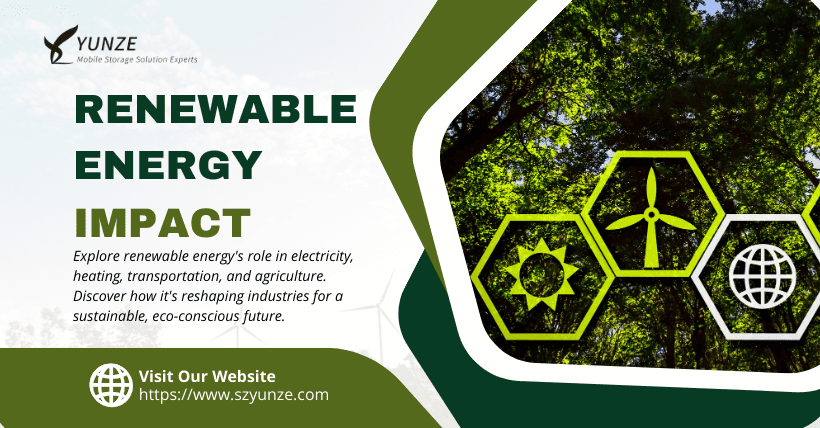Renewable energy is a game-changer in the modern world, offering environmentally friendly alternatives to traditional energy sources. It finds application across various sectors, each contributing to a sustainable and greener future. In this article, we’ll explore the diverse application areas of renewable energy, showcasing how it is transforming industries and enhancing our way of life.
Ⅰ. Electricity Industry: Lighting Up the Future
The electricity industry stands as the primary and most prominent application area for renewable energy. It plays a pivotal role in harnessing clean power from sources like wind, solar, and hydroelectric energy. Innovative technologies such as wind turbines, photovoltaic systems, and hydroelectric power stations have revolutionized the way electricity is generated. These sources channel energy into the grid, serving as a lifeline for human life and industrial production.
① Wind Energy: A Breath of Fresh Air
Wind energy is a driving force in the electricity industry. Wind turbines, with their towering blades, capture the kinetic energy of the wind and convert it into electricity. This sustainable source has gained significant momentum and has the potential to power entire cities with minimal environmental impact.
② Solar Energy: Harnessing the Power of the Sun
Solar energy, derived from the sun’s rays, is another champion in the renewable energy revolution. Photovoltaic systems convert sunlight into electricity. Solar panels have become a common sight on rooftops, harnessing this vast, clean, and abundant source of power.
③ Hydroelectric Power: Tapping into Nature’s Resources
Hydroelectric power stations use the flow of water to generate electricity. Dams and turbines ensure a steady supply of renewable energy, proving that Mother Nature herself can be a reliable source of power.
Ⅱ. Heating Sector: Keeping Us Warm and Cozy
Renewable energy extends its influence to the heating sector, providing innovative solutions for warmth and comfort. Solar energy and biomass are two key players in this domain.
① Solar Water Heaters: An Eco-Friendly Shower
Solar water heaters harness the sun’s energy to provide hot water for households and commercial establishments. These systems reduce the energy bill while lessening the carbon footprint, a win-win for both the environment and consumers.
② Biomass Energy: Heating the Way Forward
Biomass energy utilizes organic materials such as wood, agricultural residues, and waste to generate heat. Biomass boilers are the go-to choice for industries and homes looking to stay warm and eco-conscious.
Ⅲ. Transportation Sector: On the Road to Sustainability
The transportation sector is making great strides towards sustainability, and renewable energy plays a crucial role in reducing the carbon footprint of travel.
① Electric Vehicles: The Road to Zero Emissions
Electric vehicles (EVs) are transforming the way we move. These eco-friendly cars run on electricity, which can be generated from renewable sources. They’re quiet and efficient, and most importantly, they reduce our dependence on fossil fuels.
② Biofuels: A Greener Fuel Option
Biofuels, such as biodiesel and bioethanol, are alternatives to traditional gasoline and diesel. They can power not only cars but also airplanes, offering a cleaner and more sustainable mode of transportation.
Ⅳ. Agriculture Sector: Nourishing the Fields and Beyond
Renewable energy also finds its place in the agriculture sector, making farming practices more efficient and sustainable.
① Solar Irrigation: Keeping Crops Thriving
Solar energy helps pump water for irrigation in agricultural fields. This sustainable approach ensures a constant water supply for crops, promoting food security and reducing the burden on conventional power sources.
② Biomass for Waste Management: Turning Trash into Treasure
Biomass energy is a boon for the agriculture sector as it converts agricultural waste into a valuable energy source. This not only addresses waste management concerns but also facilitates energy recovery, aligning agriculture with sustainability goals.
In conclusion, renewable energy is revolutionizing various sectors, from powering our homes and industries to greening our transportation and agricultural practices. Its applications continue to expand as we strive for a cleaner and more sustainable future.
Ⅴ. Frequently Asked Questions
1. How does wind energy work, and what are its advantages?
Wind energy is generated by harnessing the kinetic energy of the wind using wind turbines. Its advantages include low environmental impact and a virtually endless supply of wind.
2. What are the environmental benefits of using electric vehicles?
Electric vehicles produce zero tailpipe emissions, reducing air pollution and dependence on fossil fuels.
3. Are there government incentives for adopting renewable energy in agriculture?
Yes, many governments offer incentives and subsidies to encourage the adoption of renewable energy in the agricultural sector.
4. How can I incorporate solar energy into my home’s heating system?
You can install solar water heaters or solar panels to harness the sun’s energy for heating your home and water.
5. What are the challenges in the widespread adoption of biofuels for transportation?
Challenges include the cost of production, availability of biofuel infrastructure, and concerns about land use for biofuel crops.

Related:



